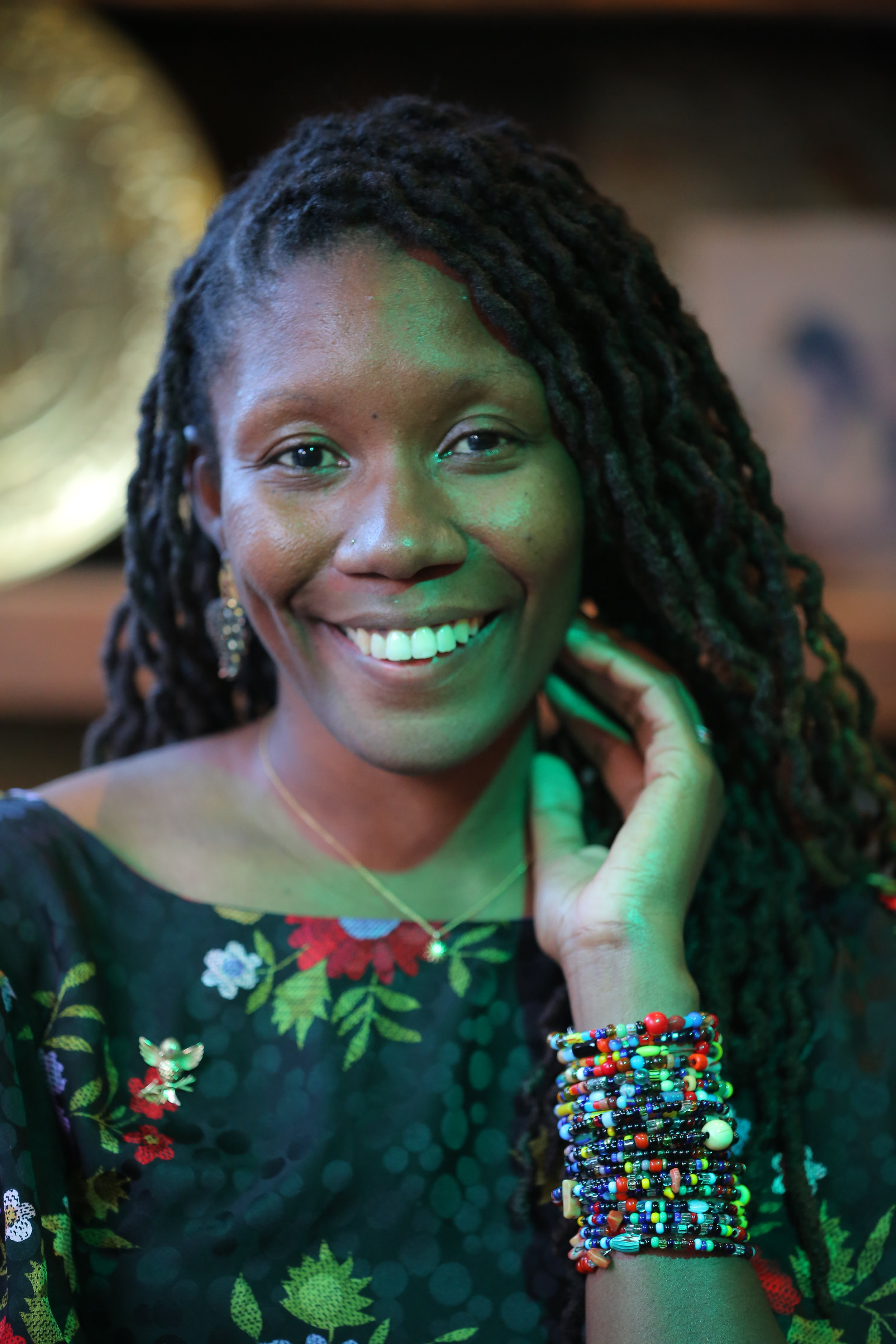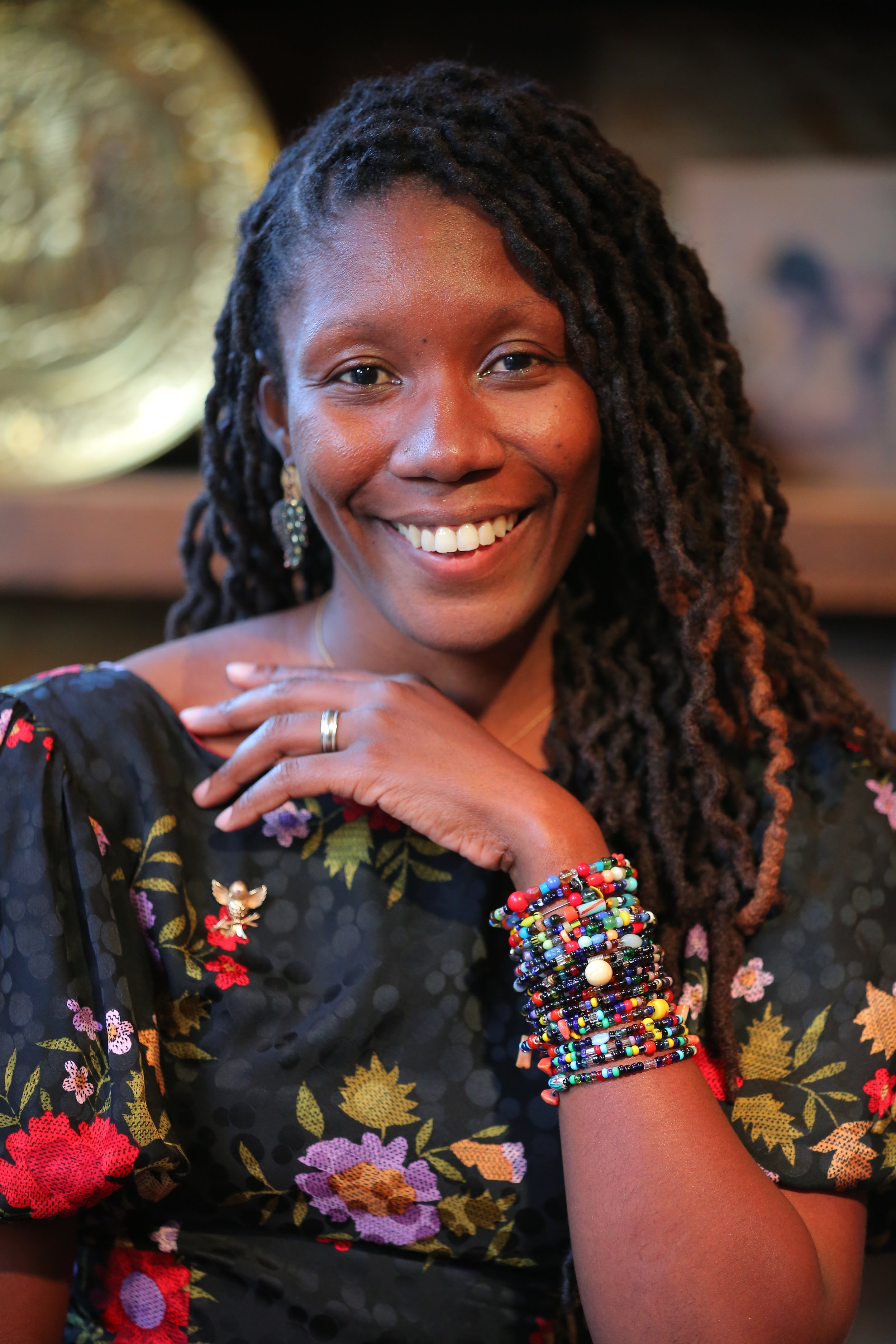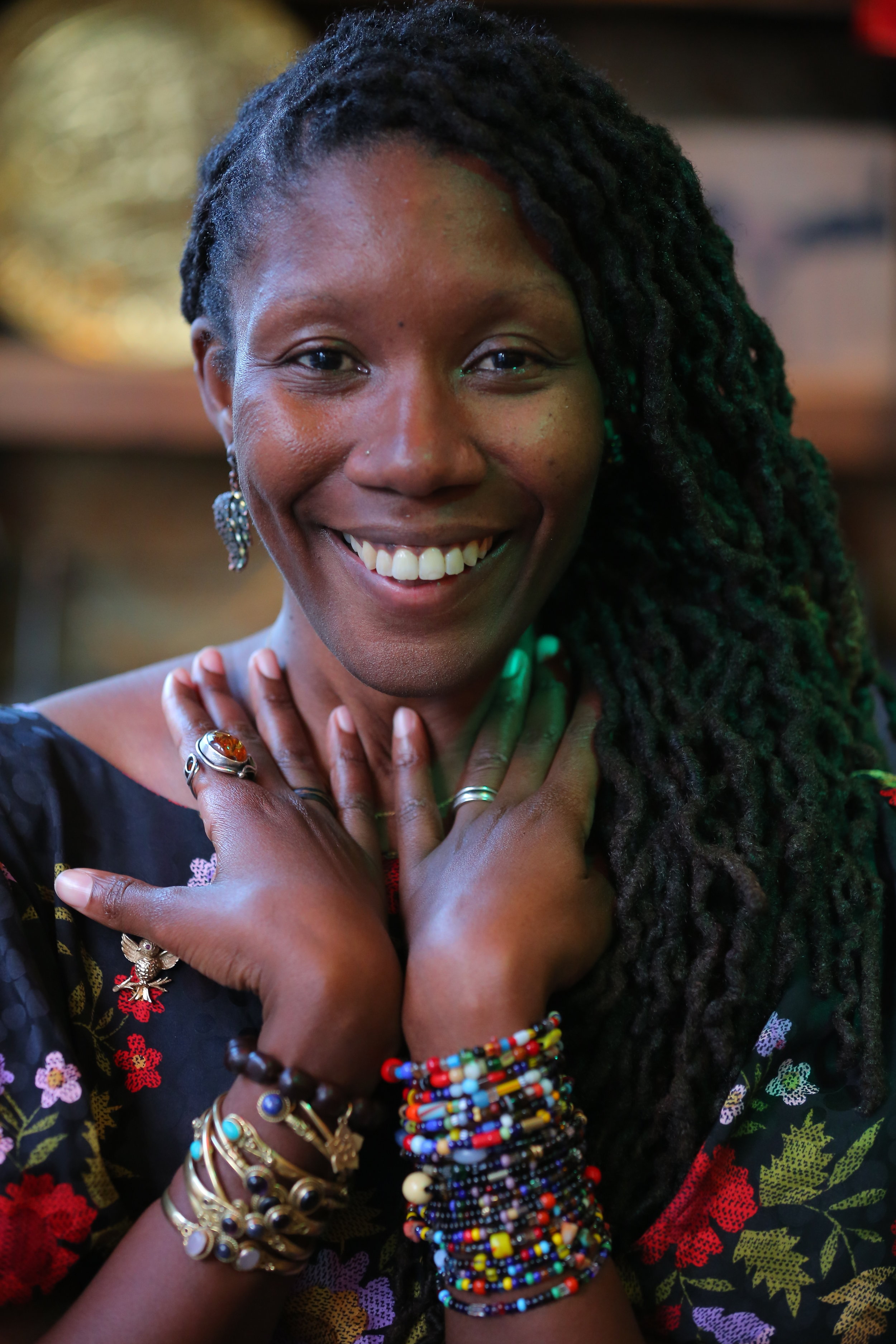AN INTERVIEW WITH NICOLE DENNIS-BENN
Red Rooster Harlem is a gathering place for the community and Nicole Dennis-Benn arrived early one chilly evening for an interview with Kweli. The hostess seated us at a booth near the bar and over a dinner of shrimp and grits, Dennis-Benn talked about the artists who “gave her permission,” black women’s sexuality, the necessity of our printed and oral art, and how she is inspired by the work of visual artists like Ndjideka Crosby, Wangechi Mutu and Ebony Patterson.
Nicole Dennis-Benn was born and raised in Kingston, Jamaica. She is the author of the highly acclaimed debut novel, Here Comes the Sun (Norton/Liveright, July 2016), a New York Times Notable Book of the Year, a NPR Best Books of 2016, an Amazon, Barnes & Noble, Entertainment Weekly, and Kirkus Reviews Best Book of 2016, a BuzzFeed Best Literary Debuts of 2016, among others. Dennis-Benn has been named a finalist for The New York Public Library Young Lions Award, the Lambda Literary Award, the Center for Fiction First Novel Prize, and the National Book Critics Circle John Leonard Award.
The following interview is an abridged version of Kweli’s conversation with Dennis-Benn.
Laura Pegram: In the acknowledgments section of Here Comes the Sun, you mentioned that Toni Morrison, Paule Marshall, Edwidge Danticat, Zora Neale Hurston and Marlon James each “gave you permission.” Can you talk about that?
Nicole Dennis Benn: I was really inspired by Paule Marshall. First of all, she is a Caribbean author, the first one I’ve ever read, who documented the complexities of our lives and the lives of women. So has author, Edwidge Danticat. Toni Morrison, has been a great influence too. When I read Sula, Beloved, and Song of Solomon, I was blown away by how Morrison unapologetically wrote the sexuality of her characters. Given that I very much wanted to capture these black women’s stories in Here Comes the Sun, I refused to do so without depicting their sexuality. Usually black women’s sexuality is not written on the page. In real life, we are socialized to be ashamed of it given that historically, our bodies never belonged to us. However, Toni Morrison has shown me that I don’t have to eliminate sexuality in order to be literary—that it’s possible and more authentic to write sex and sexuality into my narratives, because we’re human beings. We are also sexual beings.
Given that I document the lives of working-class Jamaicans, and given that language is identity, I find it necessary to write our dialect in the dialogue. I am forcing the reader to slow down just a heartbeat longer to understand them—to see and hear these people who are often invisible in our society.
Laura: In Kweli’s short story writing workshops, I frequently share two essays with my students: From the Poets in the Kitchen by Paule Marshall and The Site of Memory by Toni Morrison. So let’s begin with language and then move on from there. Early on in the submission process, the patois in your book was questioned and threatened with erasure (presumably to make the book more marketable). Can you speak to the beauty and power of our printed and oral art and also to its necessity?
Nicole: Yes, I write in Jamaican patois. Given that I document the lives of working-class Jamaicans, and given that language is identity, I find it necessary to write our dialect in the dialogue. I am forcing the reader to slow down just a heartbeat longer to understand them—to see and hear these people who are often invisible in our society. My goal is also for Jamaicans, particularly working class Jamaicans, to see and hear themselves on the page. Authenticity is very important to me. Before I learned to read, I listened. I listened to my grandmother; I listened to my mother; I listened to my great-grandmother. I was also influenced by Poet, Louise Bennett, who maintained our oral tradition of storytelling. We were colonized by the British and therefore, many of us try our best to sound, act, and look like our British counterparts. But at the end of the day, if we don’t know who we are as a people, then we will always be defeated. We were brought over on ships with no ownership of our island, no ownership of our religion, no ownership of bodies; and so, for a language to be taken away from us, it leaves us with nothing. As a writer, it’s my responsibility to maintain to preserve the only identity we have—our language.
Laura: There is something to be said about trusting one’s instincts. What would you tell a young writer who is questioning whether an agent or editor really “gets her?” And what are the costs of staying with a house out of fear?
Nicole: I really thought that it was the end of my career when I parted ways with the first agent who told me not to put Jamaican patois in dialogue. Why? I was really young. I had just graduated from the MFA program and I thought having an agent was the end all and be all. So I was devastated. However, what I learned was that when one door closes, another one opens. Once upon a time, I thought this was a clichéd statement, but it rung true when I found my current agent and an editor who got what I was trying to do.
So I would say to that young author, do not be afraid of being authentic in the creative process out of fear how you’ll be perceived. Someone out there will get it. This business is all about perseverance. It might take some time, but use that time well—continue writing and sending out work. Read agents’ bios to get a better sense of what they’re looking for, because at the end of the day it’s better to have an agent who will honor your work, honor your identity, as opposed to getting an agent just to have an agent.
Laura: Let’s segue from time to memory and imagination. In The Site of Memory, Toni Morrison writes: “the nature of my research begins with something as ineffable and as flexible as a dimly recalled figure, the corner of a room, a voice. I began to write my second book, which was called Sula, because of my preoccupation with a picture of a woman and the way in which I heard her name pronounced. Her name was Hannah, and I think she was a friend of my mother’s. I don’t remember seeing her very much, but what I do remember is the color around her —a kind of violet, a suffusion of something violet — and her eyes, which appeared to be half closed. But what I remember most is how the women said her name: how they said “Hannah Peace” and smiled to themselves, and there was some secret about her that they knew, which they didn’t talk about, at least not in my hearing, but it seemed loaded in the way in which they said her name. And I suspected that she was a little bit of an outlaw but that they approved in some way.” In Beloved, a recurring image of corn on the cob appeared to Ms. Morrison time and again before this celebrated author uncovered the mystery surrounding it. “The picture of the corn and the nimbus of emotion surrounding it became a powerful one in [Beloved].”
What strong images came to you during the writing of Here Comes the Sun? Can you give us an example? And once the image appeared, did it take time to work through the mystery?
Nicole: Definitely. I was traveling through rural Jamaica on my first trip back in many years, when I received the very first image for Here Comes the Sun. It was the image of a woman in a red dress in the field. I later had a dream about the same image. By then I had begun an outline for Thandi. But I didn’t know why I was having these flashes of this woman in a red dress in the middle of rural Jamaica, in that field. Then fast-forward to when Here Comes the Sun started to gain momentum as a story, I realized that this woman was Margot. While I was writing a scene in Here Comes the Sun of Margot wearing a red dress, I had an epiphany. The epiphany became more apparent when I stood back from my canvas and saw everything that image represented in each chapter—that of a woman desiring ownership of her land, her body, upward mobility; everything that was denied to her as a working-class Jamaican woman.
I love visual arts, so every scene I’ve written and continue to write, first comes to me as an image—be it in the museum, on the street, or on the subway. I’m inspired by everything that comes at me, whether subconsciously or consciously.
I’m inspired by Ebony Patterson, a Jamaican artist, who also portrays Jamaican working-class people. One of her most memorable exhibits was one paying tribute to the victims of the Tivoli Gardens massacre where hundreds of people were murdered when law enforcement raided the Kingston community in search of a drug lord.
Laura: Poet and photographer Rachel Eliza Griffiths recently had a solo exhibition at Poets House: American Stanzas 2006 - 2016. “American Stanzas explored the nuances of poetics, language, and imagery in relationship to Black identity.” Griffiths’ photographs, mixed media images and paintings were breathtaking and evocative. Which visual artists inspire you as you work to develop your characters or a deeper sense of place?
Nicole: I’m highly inspired by artists such as Ndjideka Crosby. She’s a Nigerian artist. She’s actually a former classmate of my wife. They went to Swarthmore together. I’m also inspired by Kehinde Wylie, who forces us to look at his subjects—mostly black men—for more than what the media portrays them as. I’m also inspired by Wangechi Mutu, who is a Kenyan artist. Most of her art, to be honest with you, has inspired Here Comes the Sun as well. Because, like me, she also documents the post-colonial scars that we carry as women in third world countries—how we bear the brunt of that with our bodies, with our sexualities, and our identities.
I’m also inspired by Carrie Mae Weems, who is a photographer. The Kitchen Table Series, won me over with its accurate depiction of black womanhood. Lastly, I’m inspired by Ebony Patterson, a Jamaican artist, who also portrays Jamaican working-class people. One of her most memorable exhibits was one paying tribute to the victims of the Tivoli Gardens massacre where hundreds of people were murdered when law enforcement raided the Kingston community in search of a drug lord. No one cared that these people were families. What Ebony Patterson did was amazing. She took these people’s lives and brought it to the art world. Implicit in each installment was her lament— “Can you look at these people? Look at who you destroyed.” And that really touched me, because in my work I also want people to look at individuals our society usually dismiss.
Laura: Photojournalists Ozier Muhammad and Terrence Jennings spent time in Johannesburg, South Africa at the Black Portraitures III Conference (Reinventions: Strains of Histories and Cultures). Black Portraiture’s organizing committee stated that “Black erasure was the original sin in the compilation of the historic record in the sciences and arts.” This conference summons us to “the notion once more that the black body itself continues to be the ultimate site of memory.” Can you talk about how the Black body, Black love, Black beauty, are defined in your work?
Nicole: It is really important for me to document the impact of colonialism on the Black body. One thing that I’ve mentioned before was Black women’s bodies. My book really documents the exploitation of the land itself as a tourist economy. However, that’s also parallel with the exploitation of women’s bodies. I really wanted to capture this in Here Comes the Sun and I also want to capture this in my other works, especially the sexualization of our young girls. We exist in a culture where men look at young girls as sexual beings before girls see themselves that way. For me, it’s really important to put that out there so that my countrymen and women can actually take notice of the fact that we are quick to condemn homosexuality, while we pardon pedophiles. These men can walk freely and no one do anything to them on the island. This sends a loud message to our young girls and young women about our worth. In Delores’s monologue, she mentions that no one loves a black girl, not even herself. She mentions this to her teenage daughter, Thandi, who is committed to bleaching her skin thinking that it will make her more worthy, valued. I think about what is going on in the United States with Black Lives Matter. For implicit in the act of bleaching, is the internalized messages we’ve gotten for generations—the fact that we don’t matter unless we are white. So, imagine the invisibility of an individual who is black and female.
Laura: In a post election article, you mentioned that you’re motivated to write against bigotry. As you work on your second novel, can you give us a window to the issues you want to address locally and globally?
Nicole: I never reveal what I’m writing about in the second book. However, the world will be a better one when we can come to the table without judging each other or dismissing each other based on perceived differences. We are inclined to think that if someone doesn’t look like us or is of another culture and religion, then they’re different from us. At the end of the day, we all desire to be seen, heard, and loved as human beings. My job as a writer is to humanize people on the page; to challenge readers to transcend their own understanding of the world and of groups of people to empathize with them.
Laura: Thank you for sharing time and truth with Kweli Journal, Nicole.
Nicole: Thank you, Laura. You asked such great questions and it was a pleasure.
Read Nicole Dennis-Benn's fiction in Kweli. What's For Sale introduces the reader to the unforgettable characters in her debut novel Here Comes the Sun.
What's For Sale by Nicole Dennis-Benn
What's in a Name by Nicole Dennis-Benn



Photo Credit: Ozier Muhammad





